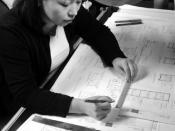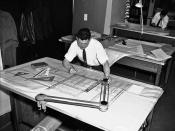Type of Work
Drafters prepare technical drawings and plans used by production and construction workers to build everything from manufactured products, such as toys, toasters, industrial machinery, and spacecraft, to structures, such as houses, office buildings, and oil and gas pipelines. Their drawings provide visual guidelines, show the technical details of the products and structures, and specify dimensions, materials, and procedures. Drafters fill in details, using drawings, rough sketches, specifications, codes, and calculations previously made by engineers, surveyors, architects, or scientists. For example, they use their knowledge of standardized building techniques to draw in the details of a structure. Some drafters use their knowledge of engineering and manufacturing theory and standards to draw the parts of a machine in order to determine design elements, such as the numbers and kinds of fasteners needed to assemble the machine.
Traditionally, drafters sat at drawing boards and used pencils and pens and other drafting devices to prepare a drawing manually.
Most drafters now use computer-aided design and drafting (CADD) systems to prepare drawings. Even though drafters use CADD a lot, it is only a tool. All drafters need the knowledge of traditional drafting techniques whether using CADD or manual drawing. Despite the near-universal use of CADD systems, manual drafting and sketching still is used.
Working Conditions
Most drafters work a standard 40-hour week; only a small number work part time. Drafters usually work in comfortable offices furnished to accommodate their tasks. They may sit at adjustable drawing boards or drafting tables when doing manual drawings, although most drafters work at a computer much of the time. Because they spend a lot of time in front of computers doing detailed work, drafters may be vulnerable to eyestrain, back discomfort, and hand and wrist problems.
Employment
Drafters held about 216,000 jobs in 2002.


